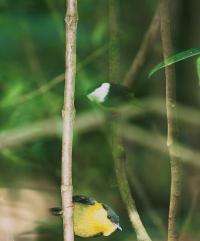Why birds of a feather lek together

Certain kinds of male birds gather into small clusters of land called leks to perform their courtship dances, and according to science, who they choose to associate with matters. A new study by University of Miami Evolutionary Biologist J. Albert Uy and his collaborators finds that some male birds are better at attracting females if they gather with close male kin, than in the company of distant relatives. The findings provide an intriguing account of why individuals help each other, especially when cooperating can be costly.
The study is titled "Kin selection may contribute to lek evolution and trait introgression across an avian hybrid zone." The article is available online in Early View and will be in print in March, Volume 21 Issue 6 of Molecular Ecology.
In relatively recent times in the evolution of life, some manakin birds of Central America split into two groups. White-collared manakins occupy the area from Mexico to Panama, while yellow-collared manakins live between Panama and Colombia. Males are colorful, while females are brown. The two species meet in northwest Panama and form leks together, which gives scientists the opportunity to see what happens when new species reunite.
The researchers found that in the area where the two manakin species come together, females are attracted to yellow-collared males more than to white-collared males, but only when there are lots of other yellow males within leks. Biologists call this effect "positive frequency dependent selection."
"Where females can compare white and yellow males simultaneously, the yellow males do a lot better than white males, but only with high numbers of other yellow males independent of lek size," says Uy, associate professor of Biology in the College of Arts and Sciences at UM and principal investigator of this project. "White males do not experience a mating advantage, regardless of lek composition."
However, only a few of the yellow males in each lek get all the girls. So why do other yellow males help? The new study finds that the yellow males within leks are more closely related than males between leks. This suggests the possibility that even less successful relatives may profit from lekking with their Don Juan-like cousins.
"We think that these yellow males that help out their relatives are benefiting by passing on their family genes indirectly," says Uy. "It's a bit controversial, but it adds evidence of what is called kin selection—selection driven by kinship—pushing some of the dynamics of lekking, as well affecting the interactions between two species when they re-establish contact."
Provided by University of Miami



















